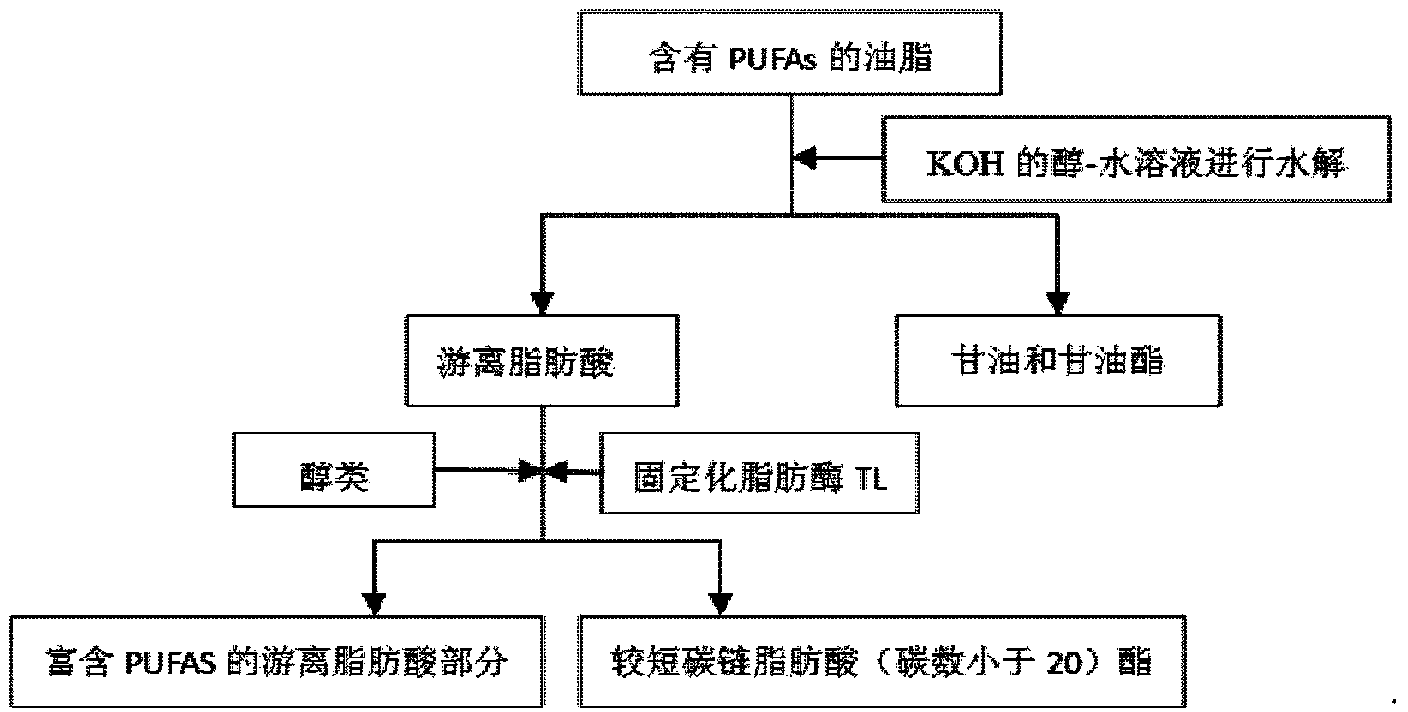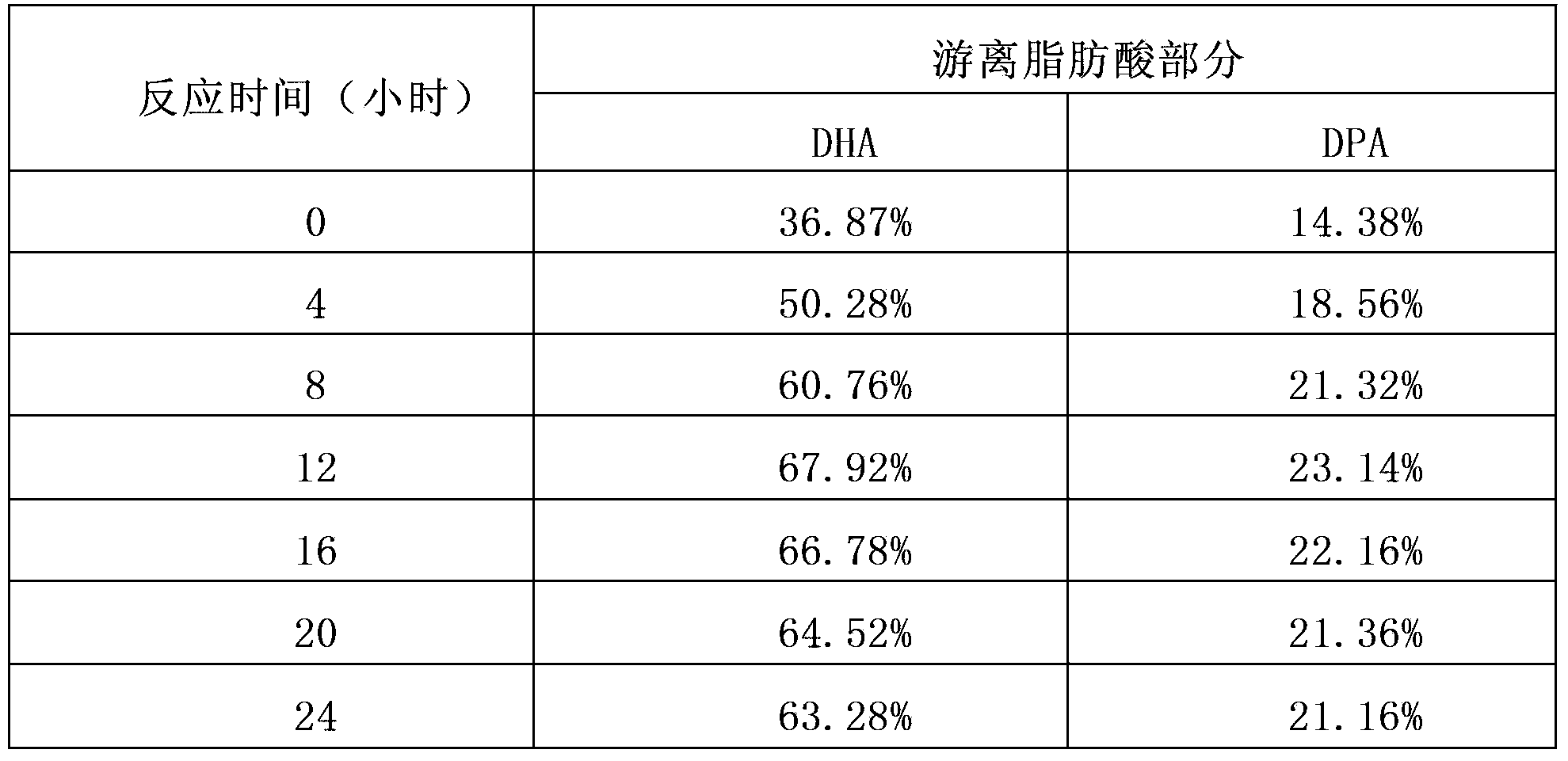Method for enriching long-chain polyunsaturated fatty acid through immobilized thermomyces lanuginosus
A technology for immobilizing lipase and unsaturated fatty acids, which is applied in the direction of fat production, fat oil/fat separation, fermentation, etc., which can solve the problems of unable to meet the market demand for high-content ω-3PUFAs, difficult hydrolysis reaction process, and low enrichment effect , achieve the effects of low price, cost saving and process simplification
- Summary
- Abstract
- Description
- Claims
- Application Information
AI Technical Summary
Problems solved by technology
Method used
Image
Examples
Embodiment 1D
[0070]Enrichment and purification of PUFAs in embodiment 1DHA algae oil
[0071] (1) Alkali-catalyzed hydrolysis: First, dissolve 36.8g KOH in 70.4mL water and 422.4mL95% ethanol to prepare KOH alcohol-water solution, add 160g DHA algae oil under nitrogen protection, and reflux for 1 hour under magnetic stirring at 50°C. Hydrolyze fats. After the reaction, add 381mL of water, extract the unsaponifiable matter with 500mL×2 n-hexane, acidify the hydrated layer with 3N HCl to pH=1, extract the free fatty acid with 300mL×2 n-hexane, and then use anhydrous Na 2 SO 4 After drying, the solvent was removed by rotary evaporation to obtain free fatty acid.
[0072] (2) Weigh 9.57g of free fatty acid prepared in step (1) and 3g of glycerol (the molar ratio of free fatty acid and glycerol is about 1:1) into a 50mL reactor, add 10% immobilized TL lipase (to react Substrate (that is, the total mass of free fatty acid and glycerol) by mass), reacted at a stirring rate of 250rpm under vacu...
Embodiment 3
[0088] Enrichment and purification of PUFAs in embodiment 3 sardine oil
[0089] (1) Alkali-catalyzed hydrolysis: First, dissolve 18g KOH in 35mL water and 210mL 95% ethanol to prepare KOH alcohol-water solution, add 70g sardine oil under the protection of argon, and reflux for 0.5 hours under magnetic stirring at 60°C to hydrolyze the oil. After the reaction, add 200mL of water, extract the unsaponifiable matter with 200mL×2 n-hexane, and use 3N HNO 3 Acidify to pH=1, extract free fatty acids with 200mL×2 n-hexane, and then use anhydrous MgSO 4 After drying, the solvent was removed by rotary evaporation to obtain free fatty acid.
[0090] (2) Weigh 9.75g of 7 parts of free fatty acid prepared in step (1), and place them in a 50mL reactor with lauryl alcohol (the molar ratio of free acid and lauryl alcohol is shown in Table 4), and add 10% immobilized TL lipase (Based on the mass of the reaction substrate), the reaction was carried out at a stirring rate of 250 rpm for 12 ho...
Embodiment 4
[0094] Enrichment and purification of PUFAs in cod liver oil of embodiment 4
[0095] (1) Alkali-catalyzed hydrolysis: First, 26.3g NaOH was dissolved in 70.4mL water and 422.4mL95% ethanol to prepare KOH alcohol-water solution. Under nitrogen protection, 150g cod liver oil was added and refluxed for 1.5 hours under magnetic stirring at 65°C to make the oil hydrolysis. After the reaction, add 381mL of water, extract the unsaponifiable matter with 500mL×2 n-hexane, acidify the hydrated layer to pH=1 with 3N HCL, extract the free fatty acid with 300mL×2 n-hexane, and then use anhydrous CuSO 4 After drying, the solvent was removed by rotary evaporation to obtain free fatty acid.
[0096] (2) Weigh 7 parts of 9.70g of free fatty acid prepared in step (1) (produced by alkali-catalyzed hydrolysis of cod liver oil), and 3g of glycerin (the molar ratio of free acid to glycerin is about 1:1) in a 50mL reactor Inside, add immobilized TL lipase (based on the mass of the reaction substr...
PUM
 Login to View More
Login to View More Abstract
Description
Claims
Application Information
 Login to View More
Login to View More - R&D
- Intellectual Property
- Life Sciences
- Materials
- Tech Scout
- Unparalleled Data Quality
- Higher Quality Content
- 60% Fewer Hallucinations
Browse by: Latest US Patents, China's latest patents, Technical Efficacy Thesaurus, Application Domain, Technology Topic, Popular Technical Reports.
© 2025 PatSnap. All rights reserved.Legal|Privacy policy|Modern Slavery Act Transparency Statement|Sitemap|About US| Contact US: help@patsnap.com



